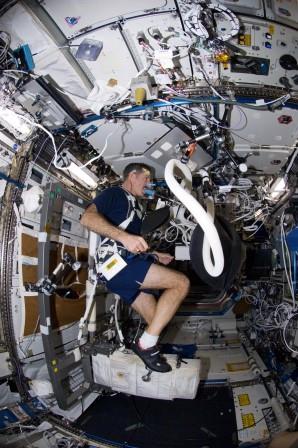Heart in space
Published in Physics

The paper in Nature Reviews Cardiology is here: http://go.nature.com/2zKYXxB
Richard L. Hughson, Alexander Helm and Marco Durante
Schlegel-University of Waterloo Research Institute for Ageing, Waterloo, Ontario, Canada
Trento Institute for Fundamental Physics and Applications (TIFPA-INFN), Trento, Italy
Microgravity substantially challenges the cardiovascular system
The space environment features a drastically reduced gravity as compared to Earth, resulting in major adaptions to the physiology of the human body. The cardiovascular system (CVS) is unloaded and the normal head-to-foot hydrostatic gradient is removed. Additionally, the crew members face an extreme sedentary lifestyle resulting in cardiovascular deconditioning and hence to an increased risk for cardiovascular disease (CVD). Protection of the CVS, counteracting the negative consequences at least partially is provided by regular physical activities on the spacecraft. However, exercise intensity and duration applied to date seem insufficient to prevent vascular changes such as arterial stiffness or insulin resistance. The CVS being impaired already by the effects of microgravity may further be more vulnerable to adverse cardiovascular effects of space radiation.

Space radiation: The big unknown for cardiovascular risk
Things are somewhat more complicated with respect to the CVS when it comes to space radiation, since its impact is much less characterized. Shielding is the only reliable option so far but its application in space is rather limited. Along with cancer and neurodegenerative effects, CVD is considered a consequence of radiation exposure. Studies on patients who received radiation in the thoracic region as a consequence of radiotherapy have revealed an increased risk of CVD and these concerns recently have been extended to low doses. Space radiation, however, is particular. Major issues for a space radiation exposure are displayed in the following:
- The estimated dose-rate for a crew on a deep space mission is relatively low, yet higher than the one of the natural background on Earth. Assumed total doses on e.g. a round-trip to Mars (about 0.5 to 1 Sv) are within the range of concern for CVD
- On earth, photons account for most of the natural radiation background but particle radiation is the predominating component of the extraterrestrial radiation background
- Particle radiation is generally more efficient than photons with respect to the induction of biological damage, but the precise biological mechanisms – especially on the CVS – for many adverse effects remain to be elucidated
The poor characterization of the biological mechanisms and the virtual lack of epidemiological data for particle radiation exposure impede a proper risk assessment. Additionally, it cannot be ruled that microgravity and space radiation synergistically increase the risk for CVD. The international space agencies and private corporations aim at extended human presence in space (e.g. Moon colony) or even deep space exploration (Mars). Thus, the increased risk of CVD for such missions needs to be addressed and research in the field is urgently needed.
The original article was published in Nature Reviews Cardiology in October 2017 and can be found here.




Please sign in or register for FREE
If you are a registered user on Research Communities by Springer Nature, please sign in